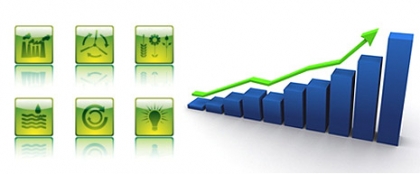We’ve all heard the expression, “companies measure what matters, and what matters gets measured.” As organizations endeavor to figure out what sustainability and green mean to them, software vendors are emerging to help. Given the lack of definition, standards and regulation, organizations are learning and taking action at their own pace, and there’s a lot for everyone – organizations, software vendors, industry groups and government – to figure out.
In the effort to explain where Sustainable Minds fits in the software landscape, we realized that we had to define this new sector, just to explain where we fit within it. For this purpose, we’ve coined the phrase ‘Sustainability Performance Software.’ Being a customer-centered product design organization, our definitions are based on who the customers and users are of these new apps, and their purposes for purchasing.
We have identified four categories in this new sector:
1. Carbon management
- For organizations to manage and report their carbon footprint to:
- Get ahead of impending carbon tax, cap and trade and/or reduction regulations. The term 'Green IT' is being used to describe a sub-set of this group used to manage carbon impacts from computing and data centers. Example: Clear Standards
- Manage and report a product’s carbon footprint to consumers. Example: Cooler
- For consumers to reduce their personal carbon footprint based on lifestyle and product purchase choices. Example: TerraPass
2. Enterprise
- For organizations to measure various aspects of its operations for compliance and other sustainability goals, in addition to carbon management. Example: Foresite Systems
3. Products
- Life cycle assessment (LCA) software for LCA expert practitioners for comprehensive LCA of systems and products to quantify environmental, social and economic impacts. Example: PE International
- LCA-based ecodesign software for product development teams for use in concept design to estimate the potential life cycle environmental and human health impacts. Example: Sustainable Minds
4. Packaging
- For package design teams to compare the life cycle environmental and human health impacts of package designs. Example: COMPASS, from the Sustainable Packaging Coalition
- For companies to reduce the environmental impacts of packaging to meet market-specified performance goals. Example: Package Modeling Software created for use with Wal-Mart's Sustainable Packaging Scorecard.
Right now, the biggest sector by far is carbon management software. Entrepreneurs and investors are placing bets the government will establish some type of carbon regulation in the near future, and they’ll be there to help when companies must comply. There’s nothing like government regulation to drive product innovation!
About carbon footprinting relative to a total life cycle environmental assessment:
LCA and carbon footprinting both model the entire life cycle of a product or system. The only difference is that LCA generally models eight to twelve impact categories (including global warming), while carbon footprinting only models one: global warming. The major drawback of carbon footprinting is that it neglects other impacts such as human toxicity and ecotoxicity, water pollution, smog, acid rain, and fossil fuel depletion, to name a few. The risk is that reducing the carbon footprint of a product or system may actually increase some of these other impacts. Read the Ask the Okala Expert post by Philip White on this topic.
Companies getting serious about sustainability will purchase a number of software products to help them innovate, manage, track and report on sustainability performance and initiatives. In smaller organizations, it's possible they’ll be purchased by the same person. In larger organizations, it’s more likely that different people will make these purchase decisions, because they serve different purposes and parts of the organization. Over time, these systems will be designed to interoperate so that sustainability can be operationalized into business as usual, to measure what matters.

